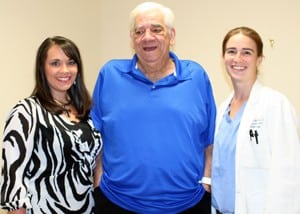Rare Lung Procedure Saves Life
| Dec. 1, 2010 | Before he came to UAMS, Paul Jones of Camden was preparing to die. The 67-year-old had a tumor on his left lung that had been discovered during a CT scan following an auto accident.
Jones was sent to a lung specialist for a biopsy to determine whether the tumor was cancerous. But due to Jones’ chronic obstructive pulmonary disease (COPD)

Paul Jones and his daughter, Erica Morgan (left), met with Mollie Meek, M.D., during Jones’ follow-up visit.
, the doctor advised him that a biopsy would cause the lung to collapse and Jones to die.
“The doctor said he’d be the last person I saw if he did the biopsy,” Jones recalled. After that, Jones said he began to get his affairs in order, assuming that he would likely die of lung cancer.
But Jones’ daughter, Erica Morgan, also of Camden, said she heard from friends that her father should go to UAMS. “They said, ‘UAMS has a good reputation for treating cancer and that’s where you need to be,’” Morgan said.
Her father insisted he wouldn’t have a biopsy, but she convinced him to at least hear what the specialists at UAMS had to say. At UAMS Jones initially saw William C. Culp, M.D., an interventional radiologist who told them that, yes, Jones’ lung would likely collapse, but it wasn’t a life-threatening issue.
“At that point we had conflicting stories, so of course we were scared,” Morgan said. Morgan and her father were reassured after talking with Culp and other UAMS doctors, including Mollie Meek, M.D., also an interventional radiologist.
“They said they would have everything ready; they were prepared to put a chest tube in,” Morgan said. “They were so optimistic, and I had 100 percent confidence in them.”
As expected, the biopsy caused Jones’ lung to collapse, but the chest tube quickly remedied the problem. The biopsy revealed that the two-centimeter tumor was a squamous cell carcinoma, an aggressive cancer. Due to Jones’ COPD, he wasn’t a good candidate for a traditional open surgery. If the tumor was not removed, Jones’ only option was to go through chemotherapy and radiation therapy.
But UAMS was able to offer an alternative to traditional surgery, being the only place in Arkansas that can perform a minimally invasive microwave ablation to get rid of the tumor.
Microwave ablation uses microwave energy to produce heat that destroys cancerous tumors. A probe-like antenna is inserted into the center of the tumor, and it transmits electromagnetic waves that cause water and other molecules within the tumor to vibrate. This generates friction and heat that kill cancer cells.
Performed by Meek, the entire procedure took about an hour, but the microwave takes only 10 minutes. The UAMS lung cancer team determined that Jones would not need chemotherapy, and he was able to go home four days after his surgery.
“Ablation was far superior to any other option available to Mr. Jones because we could target the specific site of the lesion,” Meek said.
Jones and Morgan said they couldn’t be happier with their experience at UAMS.
“UAMS saved my life,” Jones said. “Everybody was nice and just bent over backward – it was wonderful.”
Jones and Morgan said Meek was especially good at putting them at ease.
“Dr. Mollie is such an amazing doctor as far as her personality and attitude and knowledge; I could not ask for a better doctor to be dealing with my father on this,” Morgan said. “She even gave us her cell phone number.”